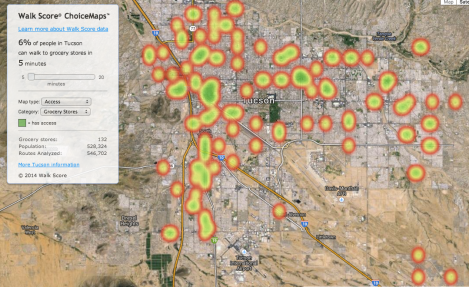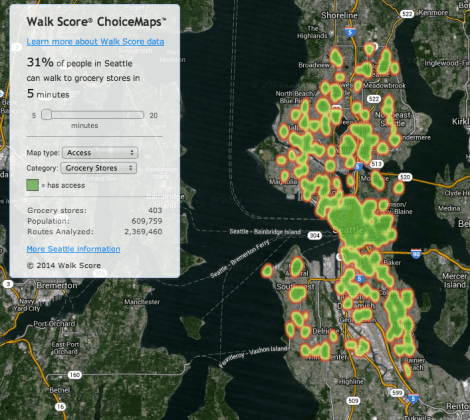
Pablo PecoraKhongoryn Els-Gobi Desert in Mongolia. Both a literal and food desert.
Food deserts are officially defined as low-income neighborhoods far away (a mile or more) from grocery stores. But distance, as the crow flies, isn’t that relevant, since only a few mutants and drone pilots navigate their cities that way. What actually matters is the time it takes to walk to the grocery store. The website Walk Score has the data to account for the hills and railroads and warehouses that separate you from food, and it has used that information to rank U.S. cities by food access.
Compare the difference between New York, where 72 percent of people live just five minutes away from a grocery store …
… and Tuscon, where only 6 percent of the population has such easy access:
Seattle is somewhere in between:
City planners already use the Walk Score data to find their food deserts. (For more on why food deserts exist, and how people are addressing the problem, check this out.) You can play with the interactive maps for the top- and bottom-ranked cities here. If your city isn’t there, you can always zoom right in on your house (and prove that you live in a pizza desert) at Walk Score’s main site.
Here’s the complete ranking of big U.S. cities by percentage of residents within a five-minute walk to food access:
- New York 72 percent
- San Francisco 59 percent
- Philadelphia 57 percent
- Miami 49 percent
- Oakland 49 percent
- Boston 45 percent
- Washington, D.C. 41 percent
- Chicago 41 percent
- Baltimore 41 percent
- Long Beach 41 percent
- Los Angeles 36 percent
- Seattle 31 percent
- Portland 29 percent
- Milwaukee 29 percent
- Minneapolis 29 percent
- Cleveland 25 percent
- San Diego 21 percent
- Detroit 19 percent
- San Jose 17 percent
- Denver 17 percent
- Fresno 17 percent
- Houston 15 percent
- Sacramento 15 percent
- Atlanta 15 percent
- Columbus 14 percent
- Dallas 13 percent
- Bakersfield 13 percent
- Memphis 11 percent
- Austin 10 percent
- Las Vegas 10 percent
- Phoenix 9 percent
- San Antonio 9 percent
- Nashville-Davidson 9 percent
- Louisville-Jefferson 9 percent
- Jacksonville 8 percent
- Fort Worth 8 percent
- El Paso 8 percent
- Arlington 8 percent
- Virginia Beach 7 percent
- Omaha 7 percent
- Tulsa 7 percent
- Albuquerque 7 percent
- Charlotte 6 percent
- Tucson 6 percent
- Kansas City 6 percent
- Mesa 6 percent
- Colorado Springs 6 percent
- Raleigh 6 percent
- Oklahoma City 5 percent
- Indianapolis 5 percent
- Wichita 5 percent





